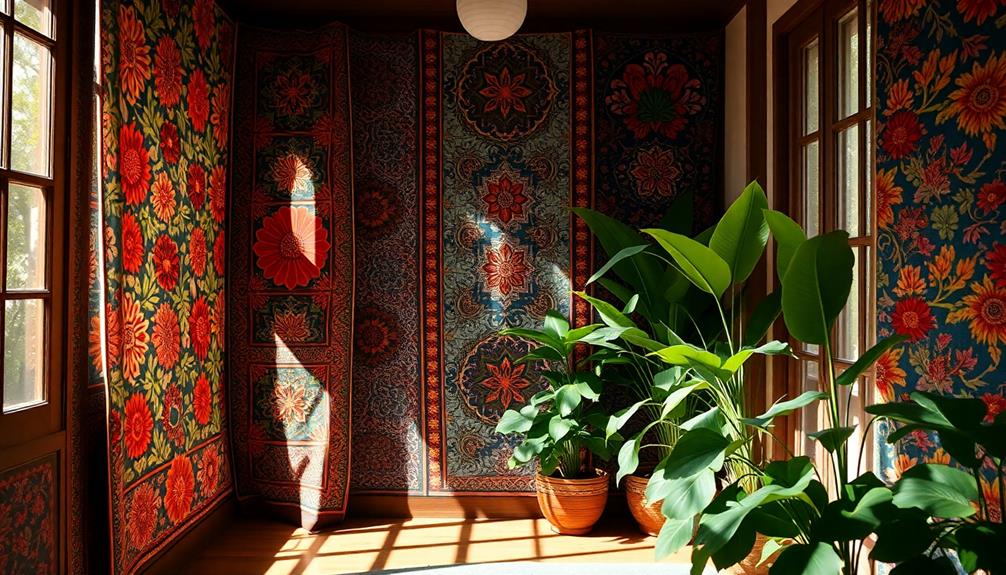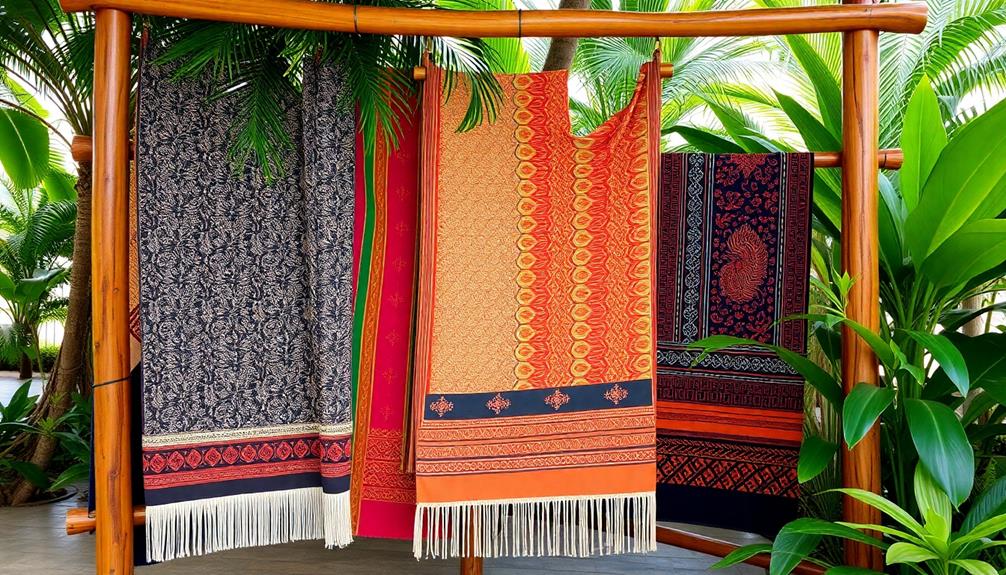Batik designs hold deep meanings that can bring a sense of peace to your space. Each motif tells a story, connecting to nature, culture, and spirituality. Patterns like Mega Mendung create a calming atmosphere, while Kawung cushions symbolize balance and serenity. By incorporating these rich textiles, you infuse your home with cultural significance, artistry, and tranquility. The wax-resist dyeing technique highlights artisan craftsmanship, adding authenticity to your decor. Adding batik pieces, such as wall hangings or throw pillows, transforms your environment into a peaceful sanctuary, inviting relaxation. You might discover even more layers of meaning that enhance your space.
Key Takeaways
- Batik patterns like Mega Mendung signify hope and create a calming atmosphere, enhancing relaxation in your space.
- The Kawung pattern represents purity and balance, promoting serenity and mindfulness in home decor.
- Incorporating batik textiles, such as throw pillows and wall hangings, adds cultural significance and visual interest to your environment.
- Each batik design reflects rich cultural narratives, fostering a deeper connection to heritage and promoting peace in your living space.
- Utilizing batik in your home decor can transform spaces into tranquil retreats, inviting relaxation and uplifting moods.
Historical Roots of Batik
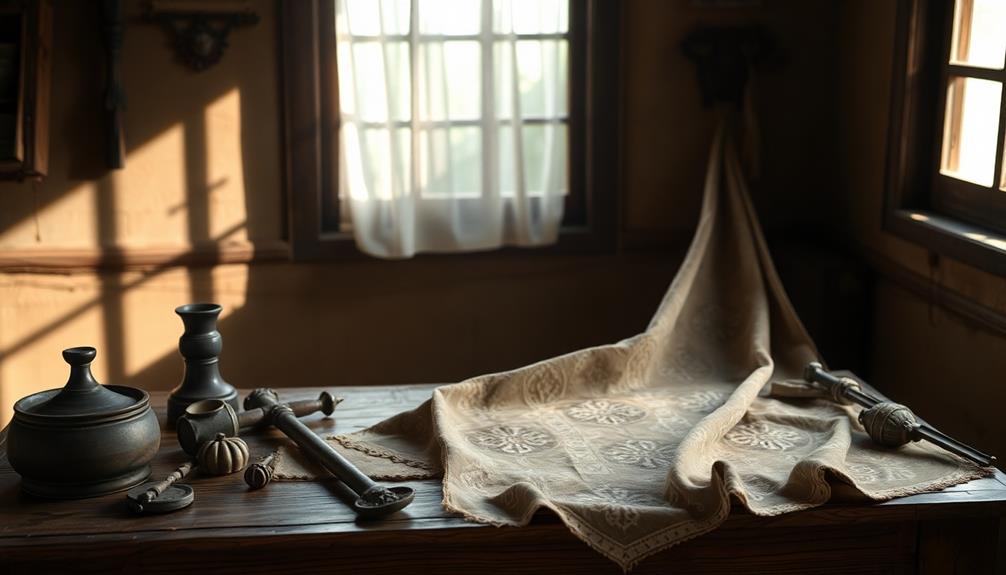
The rich heritage of batik reveals its deep historical roots, tracing back to 4th century Indonesia. As one of the oldest textile traditions in the world, batik showcases intricate techniques and unique designs that have evolved over centuries.
In 2009, UNESCO recognized batik as an Intangible Cultural Heritage of Humanity, underscoring its importance to global cultural identity. Traditional batik involves a wax-resist dyeing technique, where artisans apply wax to fabric, creating intricate designs known as batik motifs. This method allows for stunning patterns that not only showcase artistic skill but also carry significant cultural meaning.
Traditional artistry is reflected in the diverse styles of batik, much like Indonesian decor masks, highlighting the rich tapestry of Indonesia's artistic expression. Various regions in Indonesia have developed their own batik styles, each reflecting local customs, beliefs, and histories. Java stands out as the most prominent center for batik production.
Historically, the patterns and motifs in batik weren't just decorative; they often indicated social status and served as symbols of cultural pride within Indonesian society.
Understanding these historical roots not only enriches your appreciation of batik but also connects you to the stories and traditions woven into every piece.
Symbolism in Batik Patterns
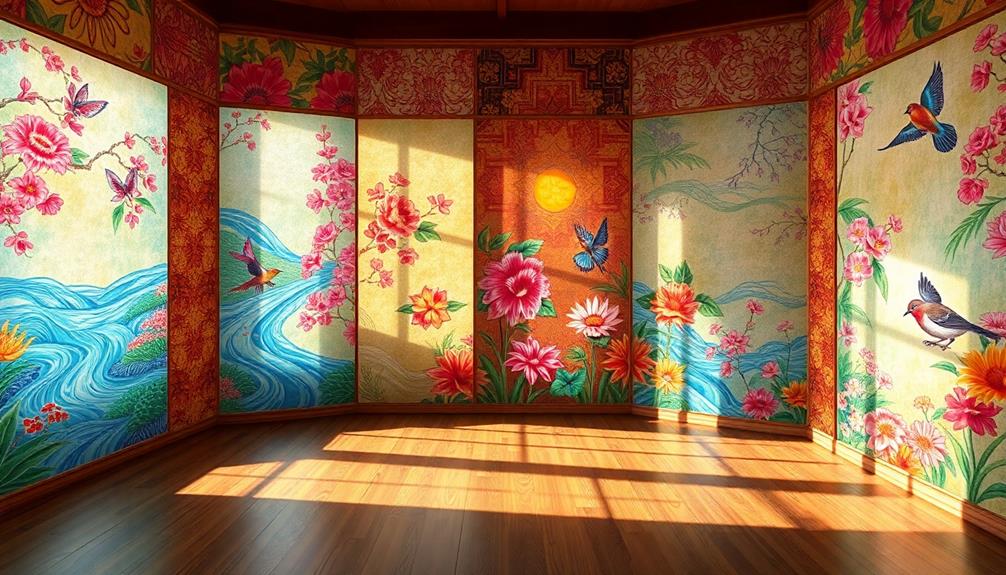
Batik patterns are more than just beautiful designs; they carry rich symbolism that reflects the values and beliefs of Indonesian culture. Each design tells a story, connecting you to nature, spirituality, and cultural narratives.
For instance, the Batik Parang pattern, known for its bold, wave-like motifs, symbolizes strength and power. This design was historically reserved for royalty, embodying dignity and protection for your space. Additionally, the intricate craftsmanship of batik enhances its appeal, making it a sought-after element in home decor, much like the Face Indonesian Decor Mask, which celebrates traditional artistry.
In the city of Cirebon, traditional batik reflects local customs and artistry, enhancing the meaning behind each piece. The Kawung pattern, resembling the sugar palm fruit, signifies purity and balance, while the Mega Mendung motif, depicting clouds, represents hope and resilience. Many choose the Mega Mendung design to create a calming atmosphere in their living spaces.
When it comes to ceremonies, Batik Sidomukti is often used during wedding ceremonies to evoke continuous glory and prosperity.
Regional Styles and Variations

Diversity in batik styles showcases the rich tapestry of Indonesia's cultural heritage, with each region presenting its own unique patterns and colors. When you explore these variations, you'll find that each design tells a story, deeply rooted in local customs and traditions. For instance, Central Java is known for its ceremonial batik, often featuring traditional earthy tones, while coastal styles leverage vibrant hues influenced by international trade.
Here's a quick comparison of some regional styles:
| Region | Notable Motifs |
|---|---|
| Central Java | Kawung (balance) |
| Cirebon | Mega Mendung (calmness) |
| Bali | Bold, dynamic patterns |
Each motif carries significant meanings. The "Kawung" pattern symbolizes balance and self-control, while the "Mega Mendung" motif embodies patience and tranquility. Additionally, designs like "Batik Sidomukti" are essential in Javanese weddings, representing continuous glory. Understanding these regional styles not only enriches your appreciation of batik but also allows you to connect with the cultural narratives each piece represents.
Incorporating Batik Into Design
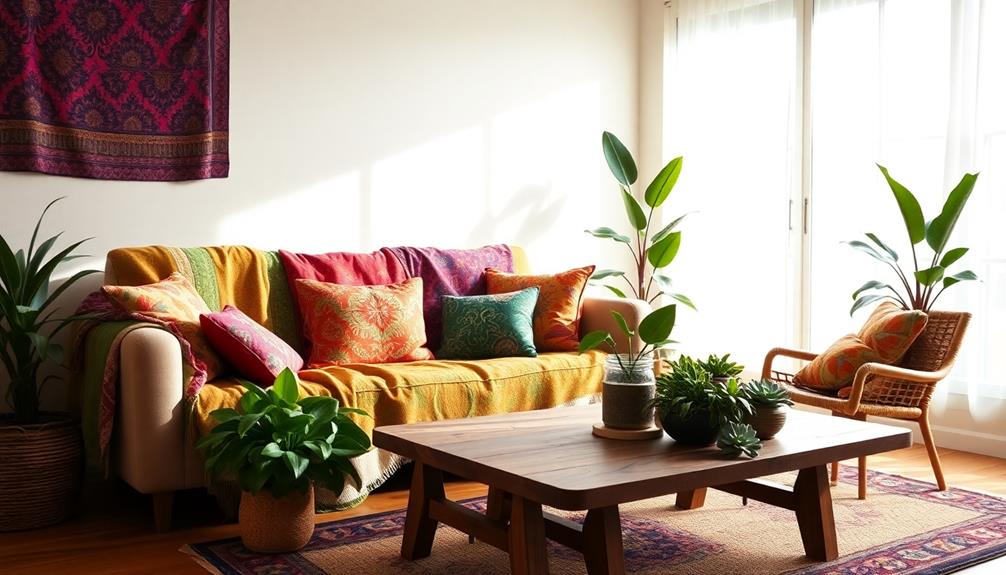
When you incorporate batik designs into your home decor, you instantly add a layer of cultural richness and visual interest. The calming atmosphere created by patterns like "Mega Mendung," which symbolize hope and prosperity, can promote a sense of tranquility in your space.
Additionally, using handcrafted pieces that reflect traditional craftsmanship can further enhance the authenticity of your decor, creating a unique ambiance that resonates with local culture. You might choose to use "Kawung" patterns that signify balance and self-control in your furnishings or wall art, enhancing the peacefulness of the environment.
Batik motifs can easily be integrated into various design elements, such as throw pillows, curtains, and wall hangings. This approach allows you to maintain a vibrant yet harmonious aesthetic throughout your home.
The rich colors and intricate designs of batik serve as focal points, drawing attention while fostering a serene atmosphere that encourages relaxation. Explore how Indonesian decorative pillows can complement these batik patterns and enhance your living space.
Techniques Behind Batik Creation
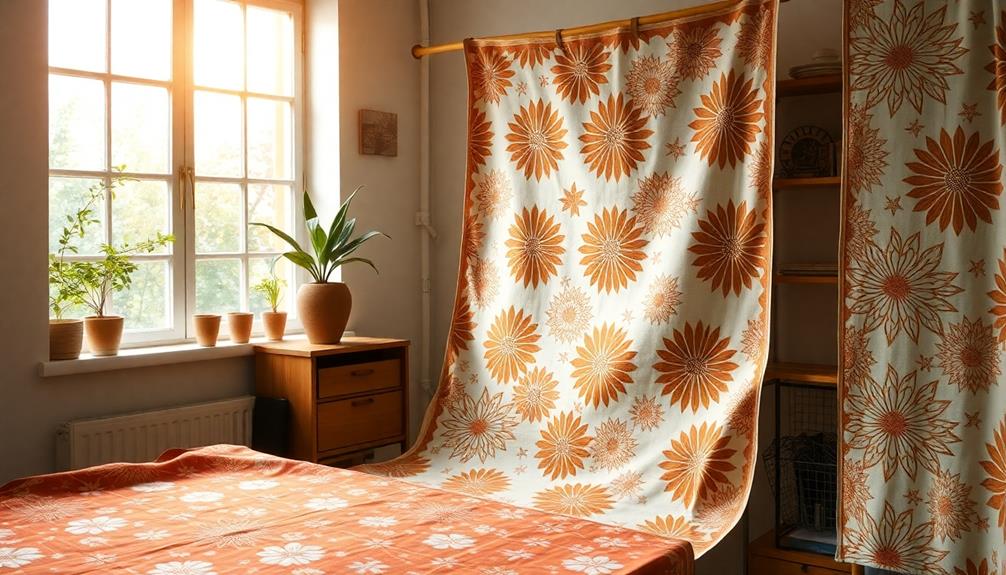
The intricate art of batik creation relies on a traditional wax-resist dyeing technique that showcases the skill and creativity of artisans.
Using a canting tool, they apply melted wax to fabric, forming detailed designs before dyeing. This process isn't just about color; it's a dance between wax and dye that requires multiple applications, allowing layers to build and evolve.
Each piece is unique, a proof of the artisan's mastery and often reflects elements of local culture, much like the importance of Indonesian decor masks.
Here are three emotional aspects of batik techniques that resonate deeply:
- Heritage: Each batik piece represents years of cultural knowledge and tradition, connecting you to a rich history.
- Skill: Artisans spend years honing their craft, ensuring that every stroke of the canting tool reflects their dedication and artistry.
- Authenticity: While modern adaptations exist, the hand-drawn or stamped methods capture the soul of batik, making each creation truly one-of-a-kind.
Batik's Role in Modern Culture
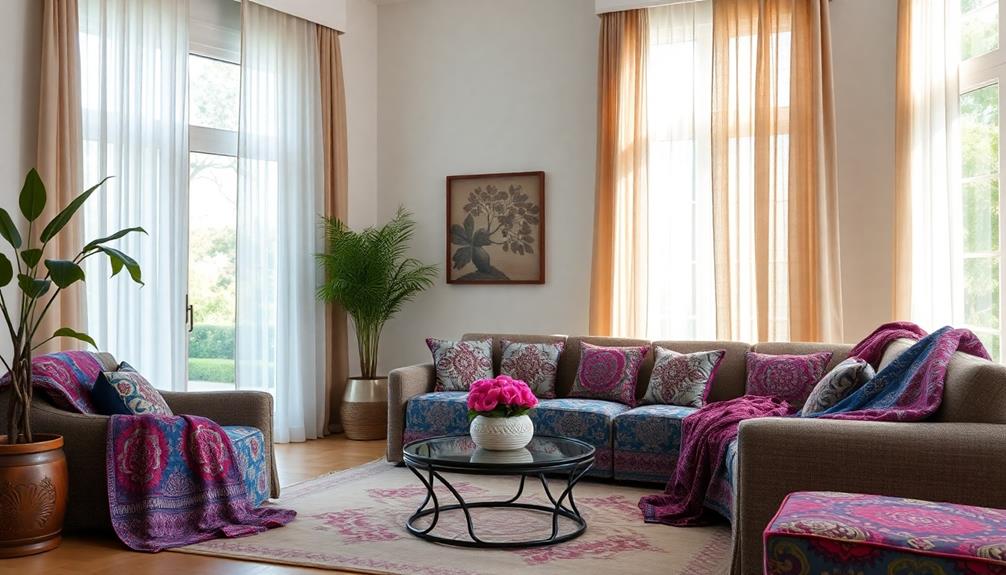
Batik's influence in modern fashion is undeniable, as you'll see its intricate patterns gracing everything from runway shows to everyday wear.
This integration not only revitalizes traditional designs but also plays an essential role in preserving cultural heritage.
The use of batik in Indonesian Wedding Decor highlights its significance and beauty, enhancing the ambiance of special occasions.
Contemporary Fashion Integration
In today's fashion scene, you can't help but notice the vibrant resurgence of batik, as designers weave its intricate patterns into contemporary clothing.
This blend of tradition and innovation not only celebrates cultural heritage but also speaks to modern aesthetic preferences.
With its rich history and significance, batik patterns can also be seen in traditional Indonesian style home decor, enhancing the beauty of living spaces.
You'll find batik's influence stretching beyond clothing to accessories and home decor, making it accessible and appealing to a wider audience.
Here are three reasons why batik's integration into contemporary fashion matters:
- Sustainability: Many fashion houses are focusing on local craftsmanship and ethical production methods, promoting sustainable fashion that resonates with environmentally-conscious consumers.
- Cultural Collaboration: Collaborations between traditional batik artisans and contemporary designers create unique collections that honor heritage while appealing to today's style sensibilities.
- Global Recognition: The increasing presence of batik in international fashion weeks showcases its versatility, proving that these age-old patterns hold a significant place in today's fashion landscape.
Cultural Heritage Preservation
Integrating batik into modern fashion doesn't just elevate style; it plays a significant role in preserving cultural heritage. Recognized as a UNESCO Intangible Cultural Heritage since 2009, batik embodies the rich narratives and social values of Indonesian society. Each design tells a story, connecting you to a deeper cultural identity.
Supporting local artisans is essential. By choosing batik, you help sustain traditional techniques passed down through generations. This craft not only enriches your wardrobe but also uplifts communities that rely on this art form. Cultural festivals, like the annual batik festivals in Indonesia, further enhance awareness and appreciation, showcasing the craft's significance.
Here's a look at batik's impact on cultural preservation:
| Aspect | Importance | Example |
|---|---|---|
| UNESCO Recognition | Highlights global cultural significance | UNESCO Intangible Heritage List |
| Historical Stories | Reflects rich cultural narratives | Designs with historical themes |
| Artisan Support | Sustains local communities and traditions | Fair trade batik products |
| Cultural Festivals | Promotes awareness and appreciation | Annual batik festivals |
| Modern Integration | Keeps tradition alive in contemporary culture | Fashion and home decor items |
Embrace batik, and you'll carry a piece of history with you.
Enhancing Spaces With Batik
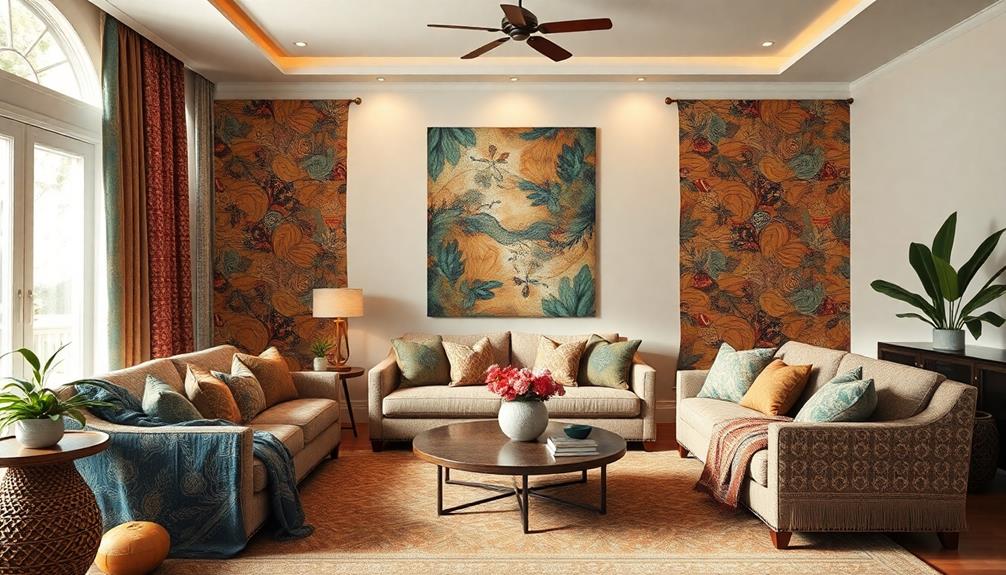
Transforming your living space into a haven of tranquility can be effortlessly achieved with the rich tapestry of batik designs. These unique patterns not only beautify your home but also bring a sense of peace and cultural significance.
For instance, incorporating batik textiles can create a soothing atmosphere that invites relaxation and mindfulness. Additionally, you can enhance your decor with traditional Indonesian wedding decor ideas that utilize vibrant colors and intricate designs, contributing to a calming environment.
Here are three ways to enhance your space with batik:
- Cushion Covers: Use "Kawung" patterned cushions to symbolize balance and self-control, encouraging a serene environment.
- Wall Hangings: Adorn your walls with "Mega Mendung" designs that represent hope and prosperity, uplifting your mood and fostering tranquility.
- Table Runners: Add a batik table runner to your dining area, infusing your meals with a sense of heritage and storytelling.
Frequently Asked Questions
What Do Batik Patterns Represent?
Batik patterns represent various elements, from nature to spirituality. Each design tells a story, reflecting values like hope, balance, and strength. By wearing them, you connect with cultural heritage and embrace deeper meanings in your life.
What Is the Significance of Batik?
Imagine wearing a batik shirt at a family gathering. Batik's significance lies in its storytelling, cultural identity, and connection to heritage. Each design you choose reflects shared values, bringing people together through rich narratives and traditions.
What Symbolizes Batik?
Batik symbolizes various concepts, like purity, hope, and love. Each pattern reflects cultural identity and personal values, allowing you to connect with deeper meanings that resonate within your space and foster a sense of tranquility.
What Is the Philosophy of Batik?
As the saying goes, "Beauty is in the eye of the beholder." The philosophy of batik emphasizes harmony, resilience, and cultural identity, encouraging you to embrace balance and nurture relationships while celebrating your unique heritage.
Conclusion
Batik isn't just a beautiful art form; it's a tapestry of culture and history that can transform your space. Did you know that over 1,000 batik patterns exist, each carrying unique meanings? By incorporating these vibrant designs into your home, you're not only enhancing the aesthetic but also inviting a sense of peace and harmony. So go ahead, embrace batik's rich symbolism and let it breathe life into your surroundings, creating a serene atmosphere you'll love.
